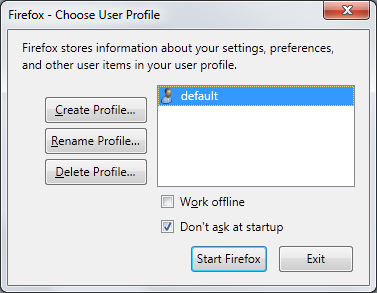

If you use the "Delete Files" option, the profile folder and files will be deleted. Delete Files removes the profile and its files (including the profile bookmarks, settings, passwords, etc.)."Don't Delete Files" is the preferred option because it saves the old profile's folder and allows you to recover the files to a new profile. Don't Delete Files removes the profile from the Profile Manager yet retains the profile data files on your computer in the storage folder, so that your information is not lost.Confirm that you wish to delete the profile:.In the Profile Manager, select the profile to remove, and click Delete Profile.When you first start Firefox with the new profile, you will be prompted to sign in to your Firefox Account so that you can sync your data with the new profile (see below).Īfter starting the Profile Manager as explained above, you can remove an existing profile as follows: You will be taken back to the Profile Manager and the new profile will be listed. To create the new profile, click Finish Done.

If you choose a folder that isn't empty and you later remove the profile and choose the "Delete Files" option, everything inside that folder will be deleted. Warning: If you choose your own folder location for the profile, select a new or empty folder. Disregard the Choose Folder prompt unless you wish to choose where to store the profile on your computer.This name is not exposed on the Internet. Use a profile name that is descriptive, such as your personal name. Click Next and enter the name of the profile.In the Profile Manager, click Create Profile.Close all instances of Firefox or restart the computer and then try again.Īfter starting the Profile Manager as explained above, you can create a new, additional profile as follows: If the Profile Manager window still does not open, Firefox may have been running in the background, even though it was not visible. The Firefox Profile Manager (Choose User Profile) window should open. Alternatively, you can use -ProfileManager instead of -P. Click the Firefox menu at the top of the screen and select Quit Firefox. If Firefox is open, close Firefox: Click the Firefox menu and select Exit.

If Firefox is already included in your Linux distribution or if you have installed Firefox with the package manager of your Linux distribution: Note: You may need to adjust these instructions if Firefox is installed in a non-default location (for example, when multiple installations exist). Start the Profile Manager when Firefox is closed


 0 kommentar(er)
0 kommentar(er)
